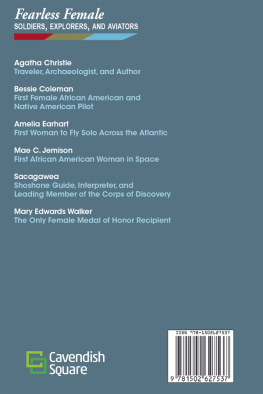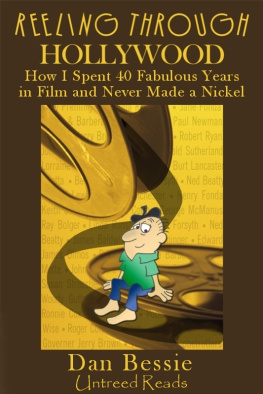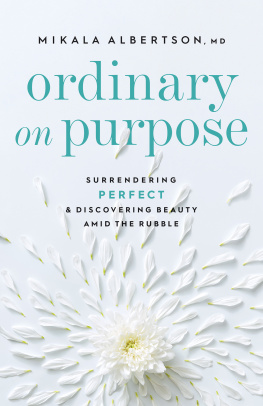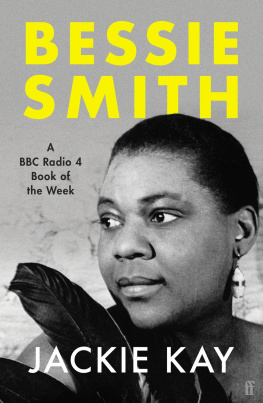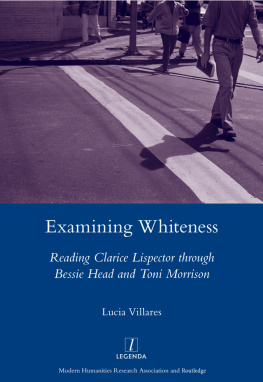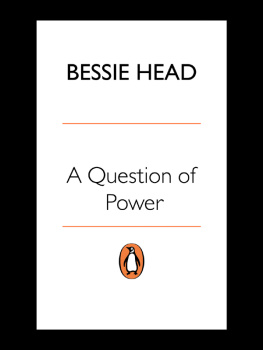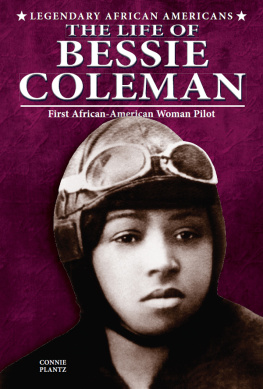Chris Albertson - Bessie
Here you can read online Chris Albertson - Bessie full text of the book (entire story) in english for free. Download pdf and epub, get meaning, cover and reviews about this ebook. year: 2005, publisher: Yale University Press, genre: Non-fiction / History. Description of the work, (preface) as well as reviews are available. Best literature library LitArk.com created for fans of good reading and offers a wide selection of genres:
Romance novel
Science fiction
Adventure
Detective
Science
History
Home and family
Prose
Art
Politics
Computer
Non-fiction
Religion
Business
Children
Humor
Choose a favorite category and find really read worthwhile books. Enjoy immersion in the world of imagination, feel the emotions of the characters or learn something new for yourself, make an fascinating discovery.

- Book:Bessie
- Author:
- Publisher:Yale University Press
- Genre:
- Year:2005
- Rating:3 / 5
- Favourites:Add to favourites
- Your mark:
- 60
- 1
- 2
- 3
- 4
- 5
Bessie: summary, description and annotation
We offer to read an annotation, description, summary or preface (depends on what the author of the book "Bessie" wrote himself). If you haven't found the necessary information about the book — write in the comments, we will try to find it.
Bessie — read online for free the complete book (whole text) full work
Below is the text of the book, divided by pages. System saving the place of the last page read, allows you to conveniently read the book "Bessie" online for free, without having to search again every time where you left off. Put a bookmark, and you can go to the page where you finished reading at any time.
Font size:
Interval:
Bookmark:
Bessie
Chris Albertson
REVISED AND EXPANDED EDITION

Copyright 2003 by Chris Albertson.
All rights reserved.
This book may not be reproduced, in whole or in part, including illustrations, in any form (beyond that copying permitted by Sections 107 and 108 of the U.S. Copyright Law and except by reviewers for the public press), without written permission from the publishers.
Original edition published in 1972 by Stein and Day.
Printed in the United States of America.
The Library of Congress has cataloged the hardcover edition as follows:
Albertson, Chris.
Bessie / Chris Albertson. Rev. and exp. ed.
p. cm.
Original edition published in 1972 by Stein and Day T.p. verso.
Includes bibliographical references (p. ) and index.
Discography: p.
ISBN 0-300-09902-9 (clothbound: alk. paper)
1. Smith, Bessie, 1898?-1937. 2. Singers United States Biography.
I. Title.
ML 420 .S 667 A 7 2003
782.421643 092 dc21
2002155414
A catalogue record for this book is available from the British Library.
The paper in this book meets the guidelines for permanence and durability of the Committee on Production Guidelines for Book Longevity of the Council on Library Resources.
ISBN-13: 978-0-300-10756-2 (pbk. : alk. paper)
ISBN-10: 0-300-10756-0 (pbk. : alk. paper)
10 9 8 7 6 5 4 3 2
The original edition of this biography saw light in 1972, at a time when published information on Bessie Smith was so scant that if one eliminated duplicated information and myth from existing books and articles, there would remain no more than ten to fifteen pages. Volume clearly exceeded substantive information in what then amounted to two biographical books, numerous chapters, and hundreds of magazine and newspaper articles. Most writings about Bessie Smith were based on her discography and recorded performances, leaving the reader with little knowledge of the person behind the voice. Ones image of Bessie, the woman, was easily reduced to a stereotypical blues-singing fat mama who drank herself out of a career and seemed not to have had much of an offstage life. The truth, as those who experienced her in person were quick to tell me, was that Bessie Smiths persona commanded as much attention as her music did and that what we hear on her recordings is but one aspect of her talent, albeit the most striking.
My own interest in Bessie Smith dates back to the late 1940s, when I was a teenager living in Copenhagen. One night, as I surfed the ether on my radio dial, Bessies big voice popped in and tested my tiny speaker. Although I spoke English, having spent most of three years in New York as a child, I did not understand the words as Bessie sang them, nor did I have a clue as to what kind of music I was listening to. But there was a compelling sincerity in Bessies voice, an indefinable quality that drew me in and made me want to hear more.
When I learned that her name was Bessie Smith and her music was the blues, I began a search that soon led me to the United States Information Service library, where I borrowed books on blues and Afro-American music in general. The USIS also boasted a sizable record department, devoted to American music, but neither jazz nor blues seemed to qualify as such. All I found was two Lennie Tristano 78-rpm discs and, tucked away in a dark corner, three or four Library of Congress discs containing field hollers and chain gang songsit was like reading the introduction and final chapter of a book. Not much, but it heightened my curiosity and opened the door to an eclectic love for jazz that over half a century of listening and exploring has not diminished.
By January 1970, my interest in African-American music had brought me back to the United States as a permanent resident. I thought I knew a lot about the music at this point, having spent more than twenty years listening and reading with no genre bias, and Bessie was one of the artists I had studied with particular interest. I had listened several times to every recording she made, read all the published stories, and seen the usual photographs. I had also spent more than two years trying to persuade Columbia Records that it was time to reissue Bessie Smiths entire recorded output, which they owned. My persistence paid off, but when the nod finally came, and Larry Hiller, my assigned Columbia engineer, and I began our restoration work, I began to realize how little I actually knew about Bessie. For nearly two years, Larry and I spent thirty-five hours a week listening intently to Bessies legacy of 159 sides, a remarkable experience that only the raw power and emotion of an artist like Bessie Smith could keep from becoming mind-numbing. When I began preparing the liner notes, my research hinted at a life that was as nuanced as her singing, but Im afraid that my album notes cast only a glimmer of new light on Bessie. Still, they brought me a decidedly undeserved Grammy award, which I can only attribute to show-biz politics.
The Grammys, the publicity generated by Columbia, and the temper of the times combined to spark a book publishers interest in Bessie, which led to the original edition of this biography. It gave me an opportunity to fill in some of the many blanks left us by previous chroniclers. One reason why the lives of many jazz performers had been treated so superficially is that there was so much ground to cover and writers had a natural tendency to concentrate on contemporary artists. Another reason is that neither early writers nor those whom they interviewed felt sufficiently liberated to be forthright. Bessie, in its first incarnation, could not have been published in the 1940s, and probably not in the 1950s, at least not without stirring up controversy. In 1972, we were urged to tell it like it is, but few jazz writers did, so I decided to throw political correctness to the wind and concludedby way of convenient rationalization, perhapsthat the Empress of the Blues probably would have been no less candid had she lived to write the book herself. Expecting some flak from the prudish jazz press, I was pleasantly surprised when only one reviewer took offense.
In the 1930s and 1940s, when jazz literature was limited to the occasional book, one would not have had difficulty finding people with personal recollections of Bessie, but that may also be why writers dealt with her so superficiallythere was no sense of urgency. Consequently, much information vanished as people passed away and memories dimmed. Still, a remarkable number of recollections were preserved, mainly because the folk and blues revival of the late 1950s and early 1960s sparked renewed interest in the origins of all African-American music and those who had helped shape it.
Were it not for a chance meeting with Ruby Walker a few months earlier, I might not have accepted the offer to write a Bessie Smith biography. Ruby and I had become friends, and our many conversations about Bessie, with whom she toured for fifteen years, had made it clear to me that a book needed to be written. At that point in time, I dont think a meaningful biography of Bessie could have been written without tapping Rubys extraordinary memoryit would certainly have been seriously undernourished without her input.
Black performersespecially older onesexercise understandable discretion when speaking to white writers; there are aspects of black life that many feel are best unshared. Its not that they have any sordid secrets to hide, but being black can be very much an in thing, and it behooves many African Americans to preserve at least part of the mystique that years of racial division has formed. As I began work on the biography and faced Ruby Walker over a microphone, she surprised me with her candor. It helped that we had already established a solid personal friendship and that the times were indeed a-changing in 1971. The Flower Generation loosened us all up and Ruby knew that it was now possibleand, indeed, trendyto let it all hang out, as the saying went.
Next pageFont size:
Interval:
Bookmark:
Similar books «Bessie»
Look at similar books to Bessie. We have selected literature similar in name and meaning in the hope of providing readers with more options to find new, interesting, not yet read works.
Discussion, reviews of the book Bessie and just readers' own opinions. Leave your comments, write what you think about the work, its meaning or the main characters. Specify what exactly you liked and what you didn't like, and why you think so.



